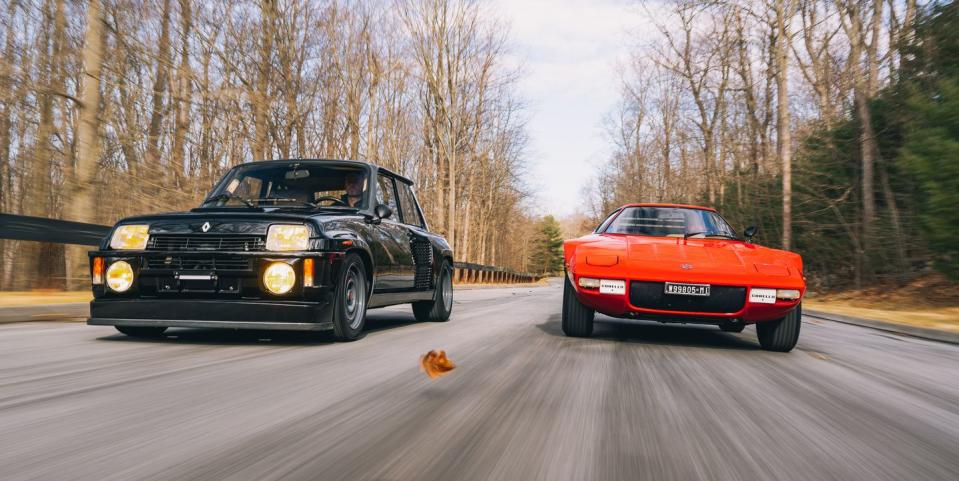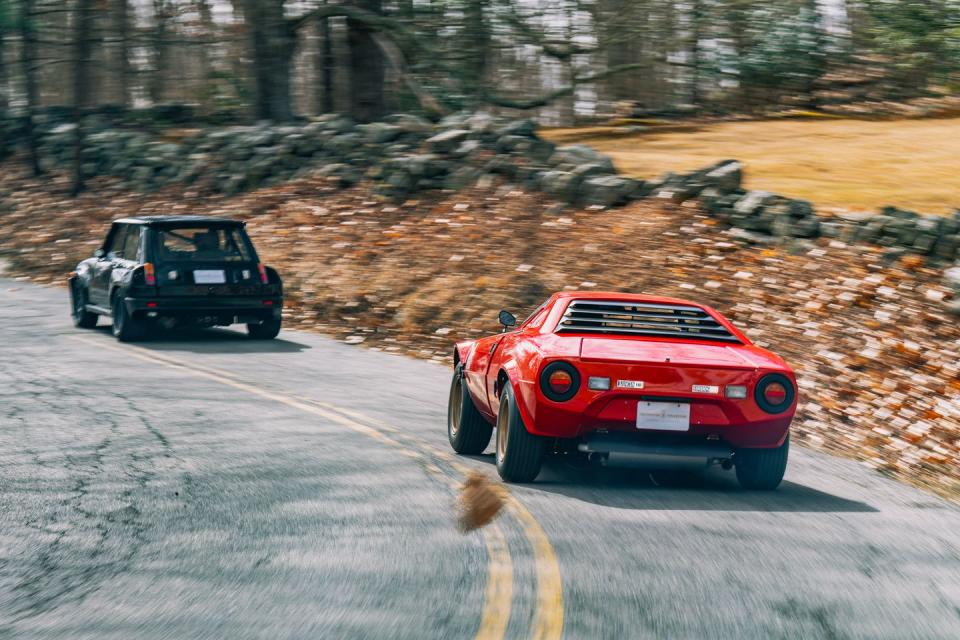Driving the Lancia Stratos and the Renault 5 Turbo II: Group 4 Legends


Modern rally, and therefore, the advent of the rally homologation special, began in the Seventies. It was in 1973 when the FIA formed the World Rally Championship, a singular series where manufacturers, teams, and drivers could test themselves against each other on a global stage. This was when standards were set, and the cars that competed then established the blueprint for all-road performance for decades to come.
Carmakers from around the planet were quick to throw their hats into the ring, with one taking the championship by storm: Lancia. Its front-drive Fulvias had seen some success in regional events, in part leading the Italian firm to create the most iconic two-wheel-drive rally car of all time to compete in the WRC, the Stratos HF.
Penned by Marcello Gandini, who worked at Bertone at the time, the Lancia Stratos HF is a tube-frame, mid-engine two-seater that takes Seventies wedge design to its most extreme. Paper-thin fiberglass clamshell body panels mean an impossibly light curb weight of under 2200 pounds, while a 270-hp V-6 taken from the Ferrari Dino resulted in some serious straightline pace.

Lancia immediately began winning races with the Stratos following its homologation for the 1974 season. Italian drivers Sandro Munari and Mario Mannucci took back-to-back wins at Rally Sanremo and Rally of the Rideau Lakes, along with a third place finish at the Lombard RAC Rally. A win by French driver Jean-Claude Andruet at Tour de Corse in France behind the wheel of a Stratos would solidify Lancia’s first place finish in the manufacturer’s championship.
The Stratos would continue to dominate. It won the WRC championship the following two years, including two 1-2-3 podium sweeps at Monte Carlo and Sanremo in 1976. By the late Seventies cars like the Fiat 131 and Ford Escort RS 1800 were beginning to catch up and surpass the wedge-shaped Lancia, leading to the company to stop its factory program with the car at the end of the 1978 season. That didn’t stop privateers from continuing to enter—and win—in top level WRC events into the early Eighties, a testament to just how good the platform was.
Lancia promised to build 500 road-going Stratos HFs to satisfy homologation rules for the WRC’s Group 4 class, though it’s estimated just 492 examples left the factory between 1973 and 1975. The car you see here, painted in Red-Orange over a “Havana” Alcantara interior, is one of those cars. Conforming with homologation rulesets, it has the same chassis design, body panels, and drivetrain as the full-on WRC version, albeit slightly detuned to about 180 hp for better street manners.

Seeing the Stratos in person gives you a good understanding of this car’s proportions. This car is small, shorter yet wider than a first-generation Miata. The sharp nose, tight greenhouse, afterburner-esqe tail lights, and canopy-like windshield give off fighter jet vibes in a package no bigger than a kei van. There’s little room inside, with the upper edge of the windshield sitting just inches from your forehead. The door panels, which double as spaces for drivers to put their helmets, do provide ample elbow room, however.
Believe it or not, this isn’t my first experience with a Stratos HF. I was lucky enough to spend some time riding in the right seat with an acquaintance while leaving a concours event back in 2016. While I never actually got behind the wheel, my stint as a passenger led me to believe the Stratos was unstable, tough to drive, and in some situations, downright sketchy.
Thankfully, this Stratos was nothing like the one I rode in all those years ago. Despite the exotic Italian drivetrain and the car’s sheer age, the driving experience was exceedingly fun, without giving off any of the scary or intimidating vibes I suspected it might. This one was sorted.

Aside from the closeness of my head to the windshield, the empty tub in each door card, and the comically narrow seats, there isn’t anything major that stands out once you sit inside. You sit low in the car, and the steering wheel is close by, right where you want it to be. The shifting action from the dogleg five-speed transmission feels natural and well weighted, as does the pedal box. The only “trick” you have to remember with this particular Stratos is to blip the throttle as you’re turning over the starter to get the engine to fire. And it fires without fail, every time.
Otherwise, the Stratos HF operates much like a normal car. The steering and brakes are unassisted, but because the car is so light, you barely notice. Shifting into first or reverse is simple and straightforward, but be sure not to rush the 1-2 shift. Once you adjust your brain to the extra-heavy throttle pedal, it’s not hard to drive the Stratos in modern traffic.
Get it onto a twister bit of tarmac, though, and you need to be paying attention. The mid-engine design and short wheelbase means the Stratos is best piloted through a combination of light steering input and precise throttle control. Take your foot off the gas, and the front tucks in more than you think it will. A well-tuned suspension means the Stratos is never nervous or scary; it’s more like a dancer partner that wants you to take full control. Factor in the all-consuming volume of induction noise, filling the tiny cabin like a wave, and you have yourself a Seventies icon that backs up its stunning looks with an equally rewarding drive.


 Yahoo Autos
Yahoo Autos 